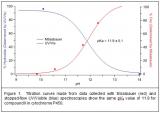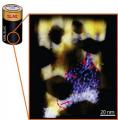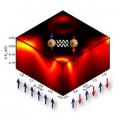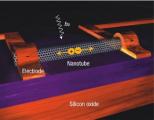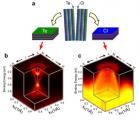Local changes of the periodontal ligament (PDL), i.e. the connective tissue fibers attaching teeth to the jaw bone, can cause abnormal dental conditions such as ankylosis, which affects growth and development of the jaw and potentially leads to jaw distortions. In a recent study researchers conducted an in-depth study of bony protrusions within the PDL space – changes that occur due to age and other factors.
Approximately 1,700 scientists visit SSRL annually to conduct experiments in broad disciplines including life sciences, materials, environmental science, and accelerator physics. Science highlights featured here and in our monthly newsletter, Headlines, increase the visibility of user science as well as the important contribution of SSRL in facilitating basic and applied scientific research. Many of these scientific highlights have been included in reports to funding agencies and have been picked up by other media. Users are strongly encouraged to contact us when exciting results are about to be published. We can work with users and the SLAC Office of Communication to develop the story and to communicate user research findings to a much broader audience. Visit SSRL Publications for a list of the hundreds of SSRL-related scientific papers published annually. Contact us to add your most recent publications to this collection.
Cytochrome P450s make up a large family of iron-containing enzymes that catalyze the oxidation of organic substances. As nature’s detoxifiers, they are responsible for 75 percent of the phase one metabolism of pharmaceuticals. A long-standing mystery of P450s is how they can perform these rather aggressive reactions without damaging their own protein structures in auto-oxidation reactions. With a recent study researchers have made a large step forward in understanding this enigmatic chemistry, opening up new possibilities for biological, medical and synthetic P450 research.
Rechargeable lithium-ion batteries are widely used in applications ranging from consumer electronics to electric vehicles. An important feature of a high-quality battery is a long lifetime, i.e. a large number of possible charge-discharge cycles. However, every cycle introduces changes in the battery’s electrode material, limiting its cyclability. A research collaboration has recently examined the occurring structural and chemical changes in the electrode material during cycling and linked them to the performance of lithium-ion batteries.
High-temperature superconductors are materials whose electrical resistance vanishes below critical temperatures that are much higher than for conventional superconductors. As potential energy-saving electrical conductor materials, they are of immense interest for a wide range of industrial applications. Despite extensive research, the exact mechanism behind high-temperature superconductivity has remained an unsolved mystery. Now, an international team of researchers has solved an important piece of the puzzle. Read more...
Fatty acids are key components of a variety of biological functions ranging from cellular membranes to energy storage. In addition, they are of great interest as potential “green” biofuels and targets in the development of novel antibiotics. In order to fully exploit their potential, researchers must first understand in detail how organisms synthesize fatty acids. However, due to the dynamic nature of the process, structural and functional studies of fatty acid biosynthesis are very challenging. A team of scientists has recently made a giant leap forward by determining the structure of a protein–protein complex that represents a snapshot of fatty acid biosynthesis in action.
Proteins are molecules with a wide range of functions in all living organisms. As potential drug targets, they are of great interest for pharmaceutical and medical research. Proteins are built from long amino acid chains that fold up into three-dimensional structures, which determine the proteins’ functions. In most cases, proteins fold into only one specific, albeit, dynamic structure. Now, scientists have determined that the protein VP40 of the Ebola virus assumes three completely different structures with three very different biological functions.
It is common knowledge that materials expand when heated. However, a chemical compound known as BiNiO3 proves to be quite extraordinary in that it contracts with rising temperature. By mixing BiNiO3 with “conventionally” expanding materials, it becomes possible to produce composite materials with zero or other desired thermal expansion values – a possibility with great potential for engineering and other applications. The same transition from a low-density to a high-density phase of BiNiO3 observed for increasing temperatures can also be induced by applying high pressure.
Carbon-based materials are extremely lightweight and have thermal, mechanical and electrical properties that are of great interest for use in functional devices. Carbon materials can be manufactured in virtually any shape and even with dimensions on the micro- and nanoscales. Recent research is now aimed at exploiting the spin and magnetism of carbon-based materials for data storage devices – a field called spintronics.
Graphite and diamond are two distinct forms of the same element, carbon. Nevertheless, their properties could not be any more different. For instance, diamond is extremely hard and can be used in cutting tools. Graphite, on the other hand, is soft and used in pencils. Graphite can be converted into diamond in a process that usually requires very high pressure. However, scientists have recently suggested an alternative route to obtain diamond-like structures from graphite – at least on the nanoscale.
Topological insulators comprise a new state of quantum matter that has been predicted theoretically and realized experimentally in the past few years. Strong inversion asymmetry in topological insulators could lead to many interesting phenomena, such as pyroelectricity, intrinsic topological p-n junctions and topological magneto-electric effects.
Researchers using Beam Line 5-4 at SSRL and Beam Line 10.0.1 at the ALS have shown the compound BiTeCl to be the first topological insulator with a strong inversion asymmetric crystal structure.


